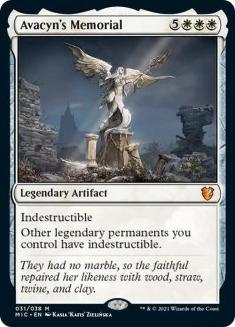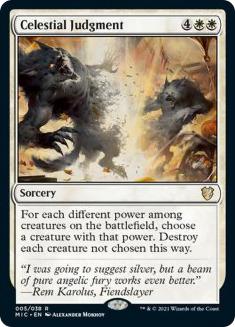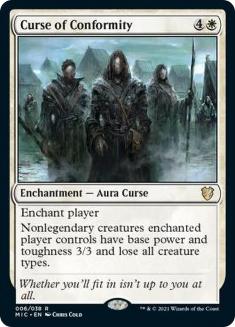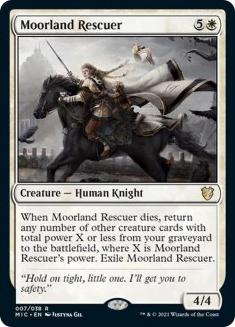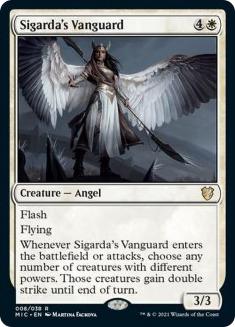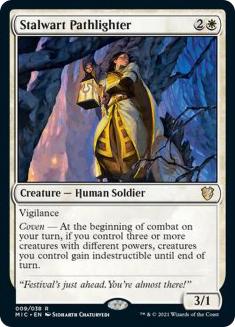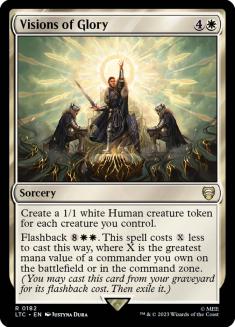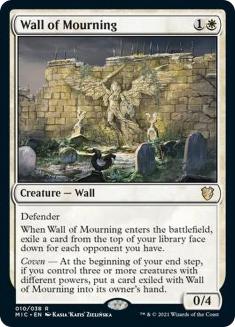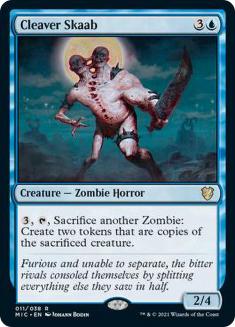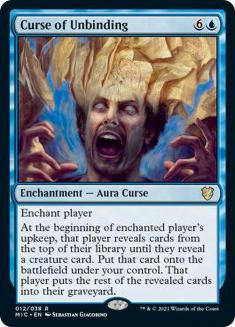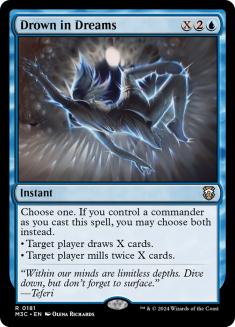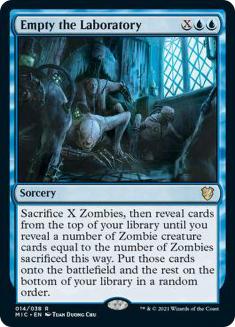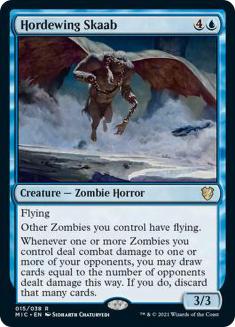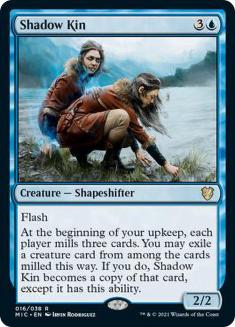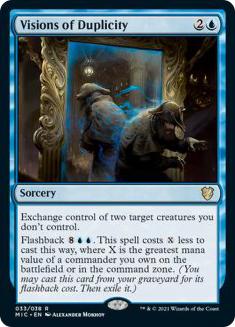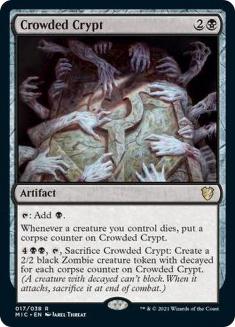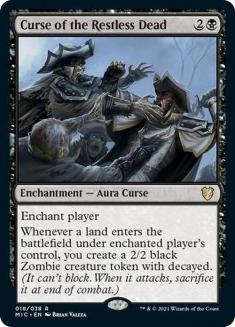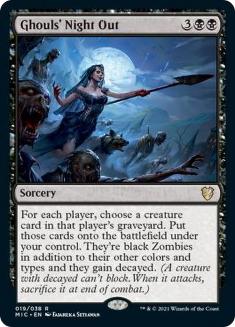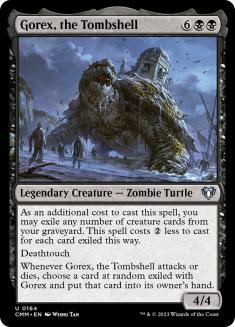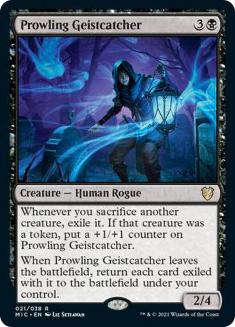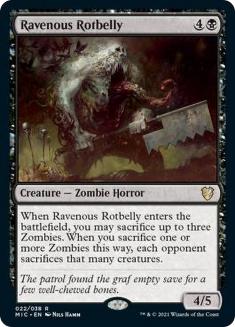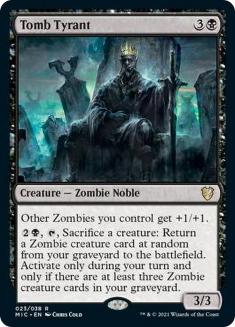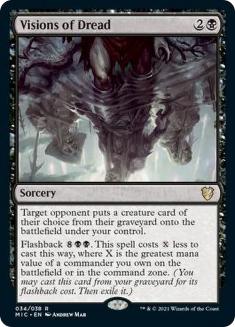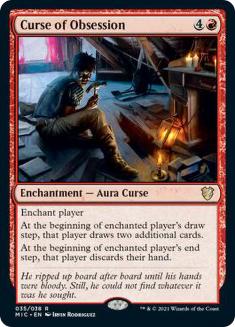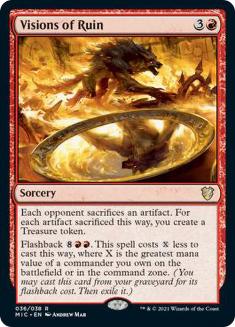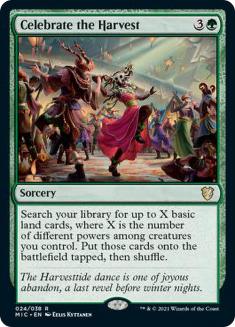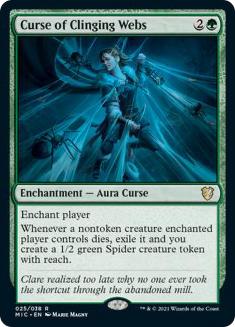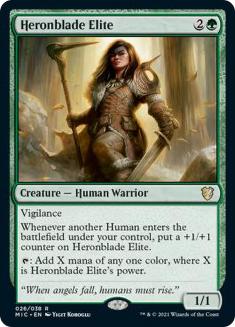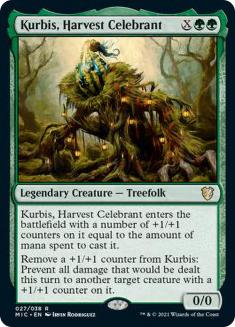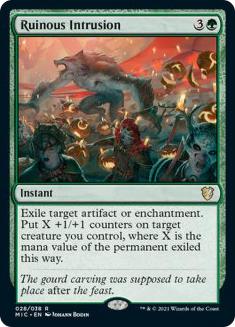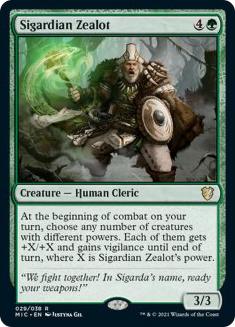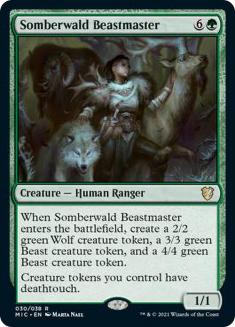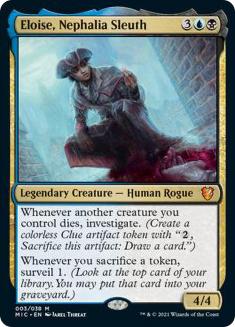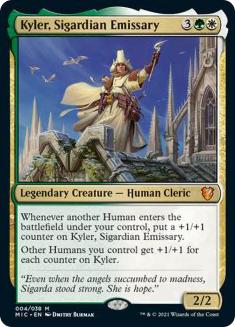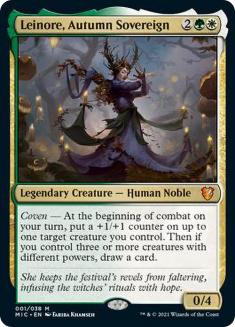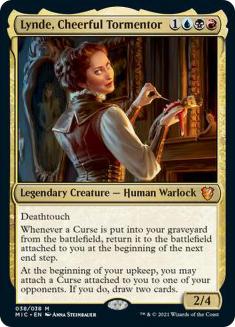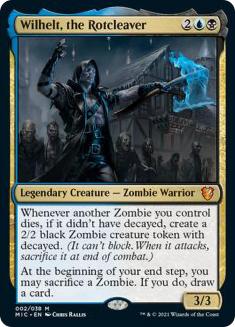The cards from the Innistrad: Midnight Hunt main set aren’t the only new ones stalking the spooky woods and creepy back alleys of the plane. We also have quite a few new ones from the Commander decks which are companions to the release. There’s already plenty of chatter around the decks themselves — once again, nicely playable right out of the box or with minimal upgrades. They’re a fine entry into the format or for experienced players who’d like a change of pace. I want to talk about the cards individually as candidates for putting into your Commander decks or maybe even building around.
I’d like to offer a brief thanks to Wizards of the Coast (WotC) for something they’ve been doing for a while now with Commander-specific releases: numbering the cards so that the new ones are first and then the reprints. It makes finding the new stuff way easier when they’re not mixed in with the reprints. There were some numbering oddities in this particular release, like the face commanders being first, but in general I’ll be very happy for them to continue this trend.
White
Based on the card name, I got very excited. The mana cost dampened said excitement quite a bit. It’s powerful and tough to get rid of (play some cards that exile stuff, friends!), but I think I’d rather have a way to cheat it onto the battlefield instead of investing eight mana, especially since it doesn’t affect all of my permanents. I suppose giving your commander indestructible is worth quite a bit, though.
You’ll be crafting your deck to take maximum advantage of Celestial Judgment, so the creatures that get left behind will most likely be yours—well worth paying the two mana past Day of Judgment. Even if you’re not building around it, you’ll choose your own creatures when there’s a tie. The problem comes when someone else has a creature like Lord of Extinction or Consuming Aberration. I suppose you’ll just need Mirror Strike to take care of them.
This seems like a Curse that you might want to put on yourself. Note that the creatures still have abilities; the Curse just negates tribal strategies. Still, turning a bunch of 1/1s into 3/3s sounds decent, especially since it doesn’t affect your legendary creatures. I’m interested to see what folks do with the card.
Well, now. This is something. It’s a variation on Reveillark (although it’s just a dies trigger, not leaves-the-battlefield). Importantly, exiling Moorland Rescuer is an instruction on resolution, meaning if you have a way to get it back into your hand, library, or the battlefield before the triggered ability resolves, you don’t have to exile it.
An Angel as a combat trick? Sweet googly moogly it’s getting dangerous out there. Flash in Sigarda’s Vanguard to wipe out a few opposing creatures, and then have it be around again to do the same for your own battles. There are two big notes on the card. First, it doesn’t target; you choose the creatures on resolution. Second, you can give opponents’ creatures double strike, so you can flash it in for a combat in which you’re not involved in order to change the math. I like what this card can do.
One that I think is quietly good, if Stalwart Pathlighter’s condition is met, all your creatures get indestructible, not just the ones with different powers. Since it doesn’t cost any mana, you’re free to play battlefield sweepers after combat, swinging a big advantage your way. I’ll definitely be jamming it into a deck.
It’s a card that scales in value to how many creatures you have, which means that it can eventually be a win-more card. With the flashback, it could be a big bomb—or just bomb out in environments with lots of battlefield sweepers. I think the value of the card will be strongly dependent on your play group.
Designers are getting pretty clever with conditional card draw in white. This one’s okay, but you run the risk of having the cards permanently exiled if Wall of Mourning goes away. No one’s targeting it with precious removal, but if there’s a battlefield sweeper coming, you could get hurt. It’s probably an acceptable risk.
Blue
Zombies are nicely represented, and Cleaver Skaab is an excellent start. Just looking at my two Zombie decks (Gisa and Geralf Together Forever and Zombies of Tresserhorn), there are some saucy choices—amplified by the fact that they’re Zombie decks, so there’s a pretty good chance that the sacrificed creature is coming back anyway. The first “dammit!” moment is of course that Grave Titan isn’t a Zombie. After emotionally processing that, we can get risky with Graveborn Muse. We can get deadly with Gray Merchant of Asphodel or Diregraf Captain. Anathemancer will also really wreck someone’s day. My only question will be which of the two decks do I put it into—or are there now enough Zombies for a third deck?
Some of the Curses Innistrad: Midnight Hunt are reasonable to put onto yourself. Curse of Unbinding, while a little spendy at seven mana, is one of them. If you have a creature-heavy deck or lots of top-of-library control, you’re in good shape. I’m more likely to find the player with the creature-light deck and turn Curse of Unbinding into a super-mill card.
For essentially the same investment in mana as Blue Sun’s Zenith (two generic mana replacing two blue), you can have a big card draw and mill a player at the same time. For dedicated mill decks, like my Millmeoplasm, this card makes a great deal of sense.
This card sings to me. As mentioned, Zombies have a habit of coming back after you sacrifice them. Whether it’s one at a time with Gisa and Geralf’s ability or a big Patriarch’s Bidding, it’s inevitable. I’ll be happy to play Empty the Laboratory alongside Tombstone Stairwell, sacrificing the tokens to grow my unliving horde. Love it.
Zombies have generally had evasion problems, Zombie Master notwithstanding. Giving them flying is kind of scary, which makes Hordewing Skaab frightening. It’s playable without the super-loot triggered ability. I’ll be happy to have as many options as possible to sort through my decks. Fun design.
Shadow Kin is very saucy. Looking at twelve cards in total each upkeep, you’re highly likely to run into something that you want Shadow Kin to become. Having flash means that it’s an end-step play and you can get right to the triggering.
Visions of Duplicity is going to lead to some chaos, the low mana value letting you cast it on a turn when you’re doing other things as well. It’d be more fun as an instant, but way more expensive, since it’d be a strong combat trick. There aren’t too many ways to abuse the card; its value is going to be in political capital, which is just fine with me.
Black
The continuing exploration of our friends in Studio X is three-cost mana rocks that are interesting. Crowded Crypt applies. It will fuel your spells early, then get you lots of Zombies later. The big play will likely be after a battlefield sweeper, when Crowded Crypt is full of counters. You’ll be right out of the recovery gate.
Someone else with a landfall deck? Take advantage of them and get a bunch of Zombies. Have your own landfall deck? Curse yourself and do the same.
The cringy pun aside, the card is solid. It’s a sorcery version of Sepulchral Primordial that also gets a creature out of your own graveyard. The card isn’t quite as a abusable since it’s not a creature; still, it’s well worth the cost and checking out the cool art.
I get where they’re going here. Effectively paying two mana for a 4/4 deathtouch creature seems okay. Getting back the creatures you delved away seems okay. The route just seems a little circuitous. Maybe the best use of Gorex is as the commander of a mono-black deck so that you can repeat the trick constantly. Note that you can use creatures in your graveyard to pay the commander tax.
Hello. Some of the cards here are really talking to me. Prowling Geistcatcher’s trigger is on leaving the battlefield, so if it’s blinked, bounced, or dies, you get back all the things exiled with it. If you have a sacrifice outlet on the battlefield, you have a pretty effective rattlesnake against sweepers—you’ll just be getting back everything. There are lots of permutations of this card being very useful, which means it’ll end up as a prime target to eat removal.
Clearly a Zombie tribal choice, though in a pinch you can also just sacrifice Ravenous Rotbelly to its own trigger. There really are enough Zombies to make that third deck. Now the question is who to lead it and which ones to rob from the other two?
Another Zombie lord is fine with me. I’ll try to not play bad Zombies, so returning one at random will be mostly fine. I like the condition so that you can’t just have one Zombie in the graveyard that you’re guaranteed to return.
For three mana, not to mention the potentially inexpensive flashback, I’ll take my chances that any opponent has only good stuff in their graveyard. Visions of Dread is my favorite of the Visions cycle from this set.
Red
There’s a fair amount of strategizing here. Letting opponents draw extra cards is usually pretty dangerous. Making it so that they can’t keep cards in order to build up to something or have interaction on other players’ turns is quite strong. It’s another Curse that you might consider putting on yourself, especially if you have an extremely low mana curve and play a high percentage of permanents.
You’ll routinely get two to three Treasures, but the opponent getting to choose the artifact they sacrifice makes it mediocre. Even with the flashback I’m not excited.
Green
If you’ve cast one-, two-, and three-power creatures in succession, Celebrate the Harvest might be better than Explosive Vegetation. In a later-game situation, it could be strong in a landfall deck, but its conditional nature gives me some pause.
Of all the Curses in the Innistrad: Midnight Hunt cycle, this is definitely the one I’m not putting on myself. I’ll be happy to keep my graveyard intact, thank you very much. Let’s eat someone else’s and get all Spidery.
The Humans deck here is clearly about exponential power. Under the right conditions, Heronblade Elite will start reminding you of Elvish Archdruid—except you’re not limited to just green mana. This seems like an explosive mana card done right, in a medium-tier tribe as opposed to an already-tired one.
A Treefolk that feels like a Hydra, Kurbis has a pretty cool ability that’s compellingly narrow. Play it in a deck with Forgotten Ancient and you spread around counters to both make Kurbis bigger (and thereby more useful) and give it more targets. For me, this card is a hit because it can be very good and it’s not just generically powerful.
You had me at “exile target artifact or enchantment.” Putting its mana value in counters on one of my creatures is just a big bonus. Although the spell won’t be countered if the targeted artifact or enchantment goes away before resolution, you still won’t get the counters because the condition of getting them is that the permanent is exiled “in this way.” I think I like the card more because you have to have a creature on the battlefield in order to cast it, a thumb in the eye of creatureless or low-creature decks.
The coven mechanic and abilities like Sigardian Zealot’s are great ways of gating the power of spells and abilities, which is healthier for the format in the long run. Like several other cards I’ve mentioned so far, they can be extremely powerful in certain situations or under specific conditions instead of being extremely powerful all the time. This offers up way more interesting gameplay and forces players to think about and evaluate battlefield states, leading to fewer instances of players just plopping their cards on the table and saying “I win.”
Seven mana made me sit up, but then I saw that it’s ten power worth of creatures and it plays right into the coven mechanic, like Trostani’s Summoner and Bestial Menace do. There are lots of creature tokens with trample and ways of giving it to them if they don’t, so having deathtouch is pretty relevant in a creature battle situation.
The baby version of Biogenic Upgrade. You’re still going to get some extreme value out of Visions of Dominance at a bargain-basement price. Potentially quadrupling the counters, via flashback, can make any number of commanders (Ghave, Guru of Spores anyone?) deadly in pretty dramatic fashion.
Multicolor
Eloise triggers on Clue tokens, Treasures, and when you inevitably sacrifice the creatures you create with Endrek Sahr, Master Breeder. You’ll be rifling through your deck and putting exactly what you want into your graveyard. She can lead a deck with the Revel in Riches win condition; alternatively, she can be a nice fit in your Anowon, the Ruin Thief Rogue tribal deck.
Clearly narrowly focused on Human tribal, Kyler reminds me that people aren’t playing enough Thief of Blood and Aether Snap (Spike Cannibal?) in Commander.
I’m a fan of the flexibility that Leinore offers you in changing the power of whatever creatures you have on the battlefield so that you can draw the card off of the coven ability. Leinore and two 2/2s mean that you can put the counter on one of the latter and fulfill the requirement. Leinore can lead many kinds of decks, not just Human tribal.
Curse tribal is here! Lynde demonstrates why many of the Curses in Innistrad: Midnight Hunt are sometimes good attached to yourself. Even if they’re old-school Curses that would be bad for you, there’s always her second triggered ability, which lets you attach it to another player and draw two cards for the privilege. Lynde is a fun build-around card that will have you thinking about cards that don’t always get a lot of love in the format. That’s just what I want new commanders to do.
More fun and potentially a new leader for your Dimir-colored Zombie tribal, Wilhelt will solve the problem of not drawing enough cards in your Zombie deck. The creature we sacrifice at the end step is just a token from Grave Titan (triggering Eloise, Nephalia Sleuth), right? Consider playing alongside Smothering Abomination.
Innistrad: Midnight Hunt Commander lets players bring home just the prey they need, stepping outside the bounds of the preconstructed decks to find saucy choices for their existing decks and using the cards in different but engaging ways. The cards continue the recent design trend of flexible but focused cards that can be extremely powerful under certain circumstances and not just simply good at all times. This is a sweet spot and a healthy direction for the format. Let’s help it continue.
Visit my Decklist Database to see my Signature Decks, the Chromatic Project, and more!


